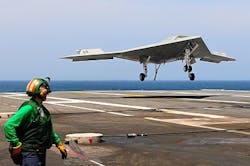X-47B unmanned fighter drone lands on carrier; ushers in new era of unmanned carrier aviation
PATUXENT RIVER NAS, Md., 11 July 2013. The U.S. Navy Northrop Grumman X-47B unmanned combat aerial vehicle (UCAV) made its first arrested landing aboard an aircraft carrier Wednesday, bringing one step closer a new era of unmanned aircraft carrier aviation.
The demonstration aboard the aircraft carrier USS George H.W. Bush (CVN 77) off the coast of Virginia Wednesday was the first time a tailless, airborne autonomous vehicle landed on a modern aircraft carrier.
Wednesday's landing begins the final part of three at-sea tests for the X-47B over the last eight months, culminating a decade of Navy unmanned integration efforts that show the Navy's readiness to move forward with unmanned carrier aviation says Rear Adm. Mat Winter, who oversees the Program Executive Office for Unmanned Aviation and Strike Weapons at Naval Air Systems Command headquarters at Patuxent River Naval Air Station, Md.
During today's testing, a mission operator aboard the carrier took control of the aircraft after it took off from Patuxent River NAS and monitored its flight, which included several planned precision approaches in preparation for the first arrested landing.
The X-47B completed the 35-minute flight from Patuxent River NAS to the carrier and caught the third wire with the aircraft's tail hook. The arrested landing brought the aircraft from 145 knots air speed to a stop in less than 350 feet. An aircraft carrier has four arresting wires on its flight deck, Navy officials say.
Shortly after the first landing, the X-47B unmanned jet fighter launched off the ship using the carrier's catapult. The X-47B then landed on and took off from the carrier one more time.
On the third approach, the X-47B aircraft self detected a navigation computer fault that forced the unmanned aircraft to divert to nearby NASA Wallops Island Air Field. The X-47B navigated to and landed at Wallops Island without incident, Navy officials say.
The arrested landings aboard the Bush mark the third major aviation achievement by the UCAS-D program since May. On May 14, the X-47B became the first unmanned aircraft to be catapult launched from a Nimitz class aircraft carrier. On May 17, the aircraft performed the first in a series of precision approaches and touch-and-go landings on a carrier by an unmanned system.
The X-47B spent several weeks aboard aircraft carriers in recent months. The Navy UCAS program completed carrier deck operations aboard USS Harry S. Truman in December 2012 and aboard the Bush in May. During the May underway period, the X-47B completed its first-ever catapult launch.
Northrop Grumman is the Navy's UCAS-D prime contractor. The company designed and produced the program's two X-47B air vehicles. An integrated test team of Northrop Grumman and Navy personnel executed the rigorous flight test and carrier suitability test sequence that culminated in today's first arrested landing of an autonomous unmanned aircraft.
Northrop Grumman's UCAS-D industry team includes Pratt & Whitney, GKN Aerospace, Eaton, General Electric, UTC Aerospace Systems, Dell, Honeywell, Moog, Wind River, Parker Aerospace, Rockwell Collins, and Lockheed Martin.
For more information contact Northrop Grumman online at www.northropgrumman.com, or Naval Air Systems Command at www.navair.navy.mil.
